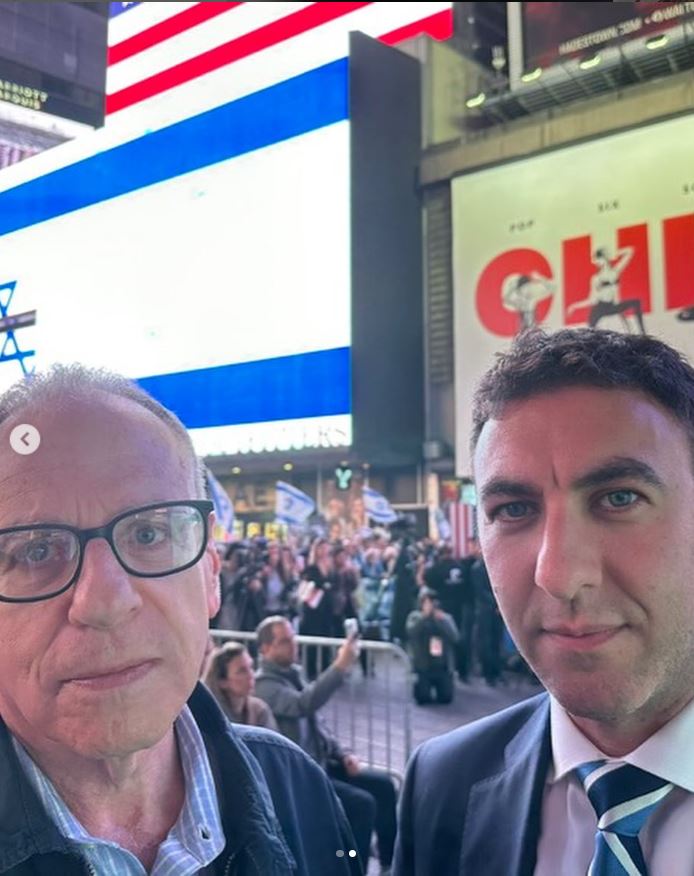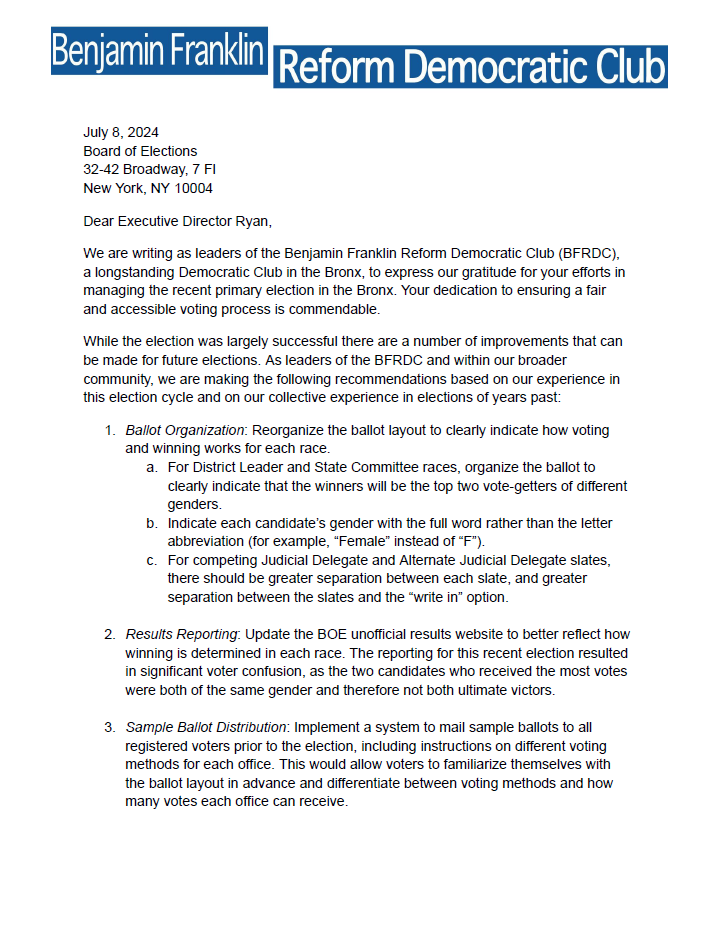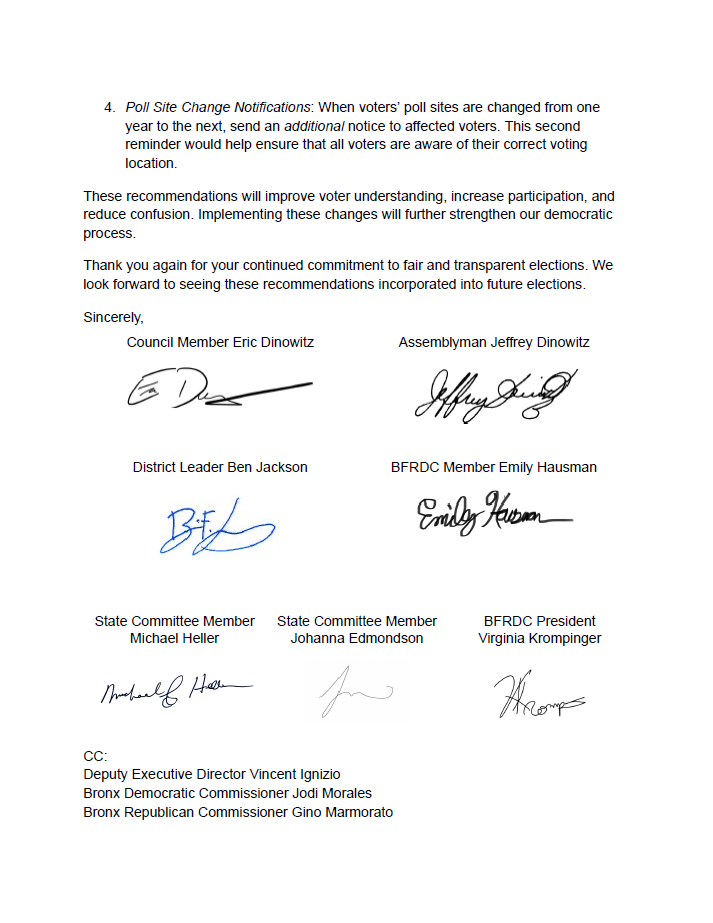
Photo courtesy of the Office of Jeffrey Dinowitz
A coalition of Bronx Democratic and Benjamin Franklin Reform Democratic Club (BFRDC) leaders, including Council Member Eric Dinowitz (C.D. 11), Assemblyman Jeffrey Dinowitz (A.D. 81), District Leader Ben Jackson (A.D. 81), State Committee Members Michael Heller and Johanna Edmondson (A.D. 81), Emily Hausman, BFRDC member, and BFRDC President Virgina Krompinger, submitted recommendations to the New York City Board of Elections (BOE) in July, which the coalition says were aimed at enhancing future electoral processes.
They said the proposals came in the wake of the June primary election in The Bronx, adding that the leaders, representing the BFRDC and broader community interests, acknowledged the BOE’s efforts in managing what they described as “a largely successful election,” while identifying areas for improvement.
Eric Dinowitz said of the proposed reforms, “We must constantly reassess the success of our elections and continue to work tirelessly to improve voter engagement and understanding. While extremists across the country and here in The Bronx seek to cast doubt upon our democratic system, our recommendations will fortify our electoral system and ensure that voters are equipped with the tools they need to remain engaged in our democratic process.”
Norwood News asked the councilman if he could be more specific about which extremists in The Bronx he was referencing, since there had been some acrimony between the BFRDC and The Bronx’s Unity Democratic Club over the recent primary elections. We also asked him if constituents had raised concerns with his office about any confusion they may have experienced at the polls during the last primaries, and if so, if he could share with us what, if any, those concerns were. We did not receive an immediate response.
The coalition said their key recommendations include:
1. Reorganizing ballot layouts to clearly indicate voting and winning mechanisms for each race, particularly for district leader and State committee positions.
2. Updating the BOE unofficial results website to better reflect how winners are determined, addressing voter confusion experienced in the recent election.
3. Implementing a system to mail sample ballots with detailed voting instructions to all registered voters prior to elections.
4. Sending additional notifications to voters affected by poll site changes to ensure awareness of correct voting locations.
Norwood News had reported on the confusion experienced by some voters during the latest June primary. We reached out to NYC Board of Elections at the time explaining that two voters at P.S. 207 in Kingsbridge, located at 3030 Godwin Terrace said they initially believed the primary elections were just for congressional races, and didn’t realize until they got to the polls that there were other local races in which they could vote.
We were informed by Bedford Mosholu Community Association (BMCA) that some of their members said the same thing. We asked the BOE if it was not made clear to voters that there were local elections for Democratic district leaders. We did not receive an immediate response.
As reported, we also reached out to the Bronx Democratic Party for more information on the various Democratic Party positions and what exactly they entail in order to share this information with readers and prospective candidates. We did not receive an immediate response. We also reported that not all party positions were listed on the Bronx Democratic Party’s website and asked the Party about this. We were informed that it would duly be updated.
We also asked the party in the interests of democracy why some Bronx Democratic Party members hold dual roles within the Party. We did not receive an immediate response, though the description of each party position is now better explained on the website.

Source: Benjamin Franklin Reform Democratic Club
Meanwhile, Jeffrey Dinowitz said of the coalition’s proposals, “We’ve taken many steps in recent years to improve the electoral process in New York and to try to increase turnout. We have more work to do.” He added, “If the suggestions that we have made are enacted, they will make it simpler to understand the ballot, give more information to people about what they’re voting on, make sure people know where they can go to vote, and ensure that they can see accurate results. We need to make these changes as quickly as possible.”
For her part, Krompinger said as the coalition strived for a more inclusive party structure and opportunities for leadership across genders, challenges related to ballot clarity were to be expected. “The Benjamin Franklin Reform Democratic Club has a storied history of promoting progressive electoral reforms. As President of the largest Democratic Club in the Bronx, I’m confident the Board of Elections will take our recommendations into account for future elections.”
As reported in the past, the BFRDC has been at the center of some prior electoral controversies. The club denies any wrongdoing.
Jackson also shared his comments, saying voting and viewing election results should always be easy and straightforward, not confusing and frustrating. “These proposed reforms will go a long way to fixing the issues we heard about from voters across the North Bronx during our recent primary elections,” he said.
Heller said that when a voter looks at a ballot with many names and many offices in a seemingly random order, a lot of confusion may take place. “Based on our experience, future ballots should contain all necessary information for voters to make informed decisions about how their votes are tabulated.”
Meanwhile, Hausman said, “As an educator and community leader, I’ve seen firsthand how confusing ballot design and lack
of information can discourage civic participation. Clear, informative ballots and sample ballots are crucial for nurturing an engaged citizenry.” She added, “Just as we strive to make learning accessible for our youngest students, we must ensure our democratic process is easily understood by all voters, regardless of their background or experience with politics.”

Source: Benjamin Franklin Reform Democratic Club
Finally, Edmondson said that in her work, “empowering women, both in fitness and politics,” she has learned that clarity and accessibility are key to participation. “Just as we design our gym to be welcoming and intuitive for women of all fitness levels, our
ballots should be clear, accessible and informative for voters of all backgrounds,” she said. “Improving ballot design and access isn’t just about reducing confusion – it’s about fostering an inclusive democracy where every voice, especially those traditionally underrepresented, can be heard and counted.”
The coalition said that in summary the signed proposal emphasizes the importance of clear communication and voter education in maintaining fair and transparent elections.
A copy of the letter (in two parts) as sent to the BOE is attached above.




